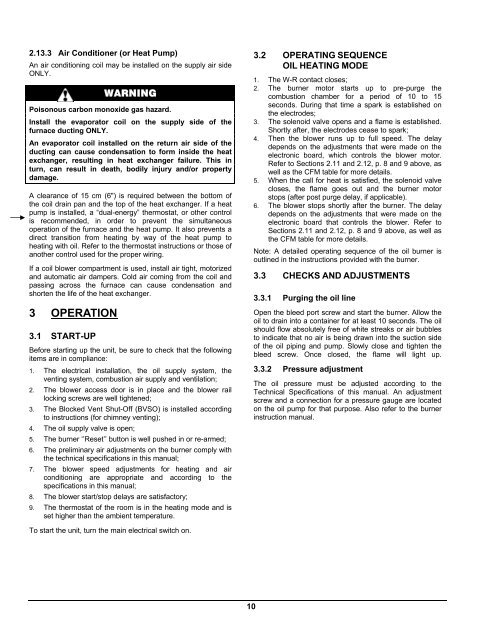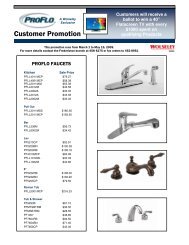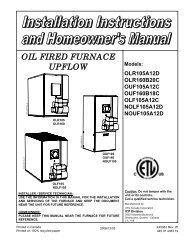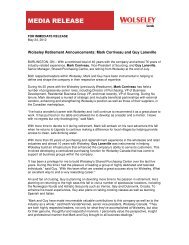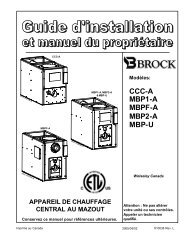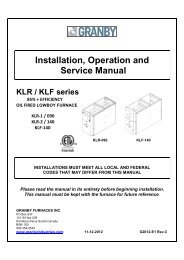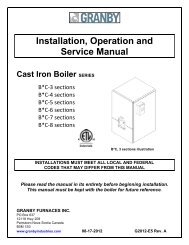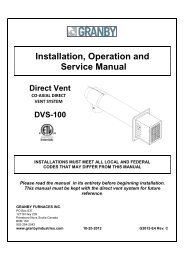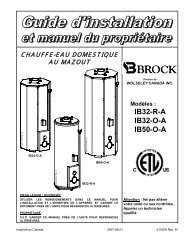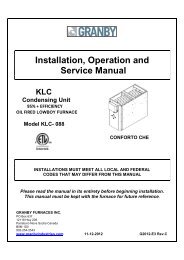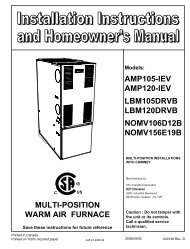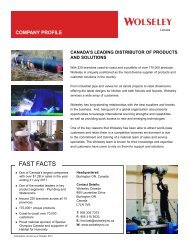OMF098J10B OMV098J12B - Wolseley Canada Inc
OMF098J10B OMV098J12B - Wolseley Canada Inc
OMF098J10B OMV098J12B - Wolseley Canada Inc
You also want an ePaper? Increase the reach of your titles
YUMPU automatically turns print PDFs into web optimized ePapers that Google loves.
2.13.3 Air Conditioner (or Heat Pump)<br />
An air conditioning coil may be installed on the supply air side<br />
ONLY.<br />
WARNING<br />
Poisonous carbon monoxide gas hazard.<br />
Install the evaporator coil on the supply side of the<br />
furnace ducting ONLY.<br />
An evaporator coil installed on the return air side of the<br />
ducting can cause condensation to form inside the heat<br />
exchanger, resulting in heat exchanger failure. This in<br />
turn, can result in death, bodily injury and/or property<br />
damage.<br />
A clearance of 15 cm (6") is required between the bottom of<br />
the coil drain pan and the top of the heat exchanger. If a heat<br />
pump is installed, a “dual-energy” thermostat, or other control<br />
is recommended, in order to prevent the simultaneous<br />
operation of the furnace and the heat pump. It also prevents a<br />
direct transition from heating by way of the heat pump to<br />
heating with oil. Refer to the thermostat instructions or those of<br />
another control used for the proper wiring.<br />
If a coil blower compartment is used, install air tight, motorized<br />
and automatic air dampers. Cold air coming from the coil and<br />
passing across the furnace can cause condensation and<br />
shorten the life of the heat exchanger.<br />
3 OPERATION<br />
3.1 START-UP<br />
Before starting up the unit, be sure to check that the following<br />
items are in compliance:<br />
1. The electrical installation, the oil supply system, the<br />
venting system, combustion air supply and ventilation;<br />
2. The blower access door is in place and the blower rail<br />
locking screws are well tightened;<br />
3. The Blocked Vent Shut-Off (BVSO) is installed according<br />
to instructions (for chimney venting);<br />
4. The oil supply valve is open;<br />
5. The burner ‘’Reset’’ button is well pushed in or re-armed;<br />
6. The preliminary air adjustments on the burner comply with<br />
the technical specifications in this manual;<br />
7. The blower speed adjustments for heating and air<br />
conditioning are appropriate and according to the<br />
specifications in this manual;<br />
8. The blower start/stop delays are satisfactory;<br />
9. The thermostat of the room is in the heating mode and is<br />
set higher than the ambient temperature.<br />
3.2 OPERATING SEQUENCE<br />
OIL HEATING MODE<br />
1. The W-R contact closes;<br />
2. The burner motor starts up to pre-purge the<br />
combustion chamber for a period of 10 to 15<br />
seconds. During that time a spark is established on<br />
the electrodes;<br />
3. The solenoid valve opens and a flame is established.<br />
Shortly after, the electrodes cease to spark;<br />
4. Then the blower runs up to full speed. The delay<br />
depends on the adjustments that were made on the<br />
electronic board, which controls the blower motor.<br />
Refer to Sections 2.11 and 2.12, p. 8 and 9 above, as<br />
well as the CFM table for more details.<br />
5. When the call for heat is satisfied, the solenoid valve<br />
closes, the flame goes out and the burner motor<br />
stops (after post purge delay, if applicable).<br />
6. The blower stops shortly after the burner. The delay<br />
depends on the adjustments that were made on the<br />
electronic board that controls the blower. Refer to<br />
Sections 2.11 and 2.12, p. 8 and 9 above, as well as<br />
the CFM table for more details.<br />
Note: A detailed operating sequence of the oil burner is<br />
outlined in the instructions provided with the burner.<br />
3.3 CHECKS AND ADJUSTMENTS<br />
3.3.1 Purging the oil line<br />
Open the bleed port screw and start the burner. Allow the<br />
oil to drain into a container for at least 10 seconds. The oil<br />
should flow absolutely free of white streaks or air bubbles<br />
to indicate that no air is being drawn into the suction side<br />
of the oil piping and pump. Slowly close and tighten the<br />
bleed screw. Once closed, the flame will light up.<br />
3.3.2 Pressure adjustment<br />
The oil pressure must be adjusted according to the<br />
Technical Specifications of this manual. An adjustment<br />
screw and a connection for a pressure gauge are located<br />
on the oil pump for that purpose. Also refer to the burner<br />
instruction manual.<br />
To start the unit, turn the main electrical switch on.<br />
10


